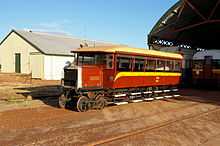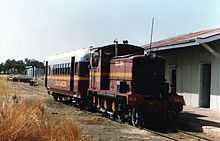Gulflander
| Gulflander | |
|---|---|
|
RM93 at Golden Gate near Croydon in August 2008 | |
| Overview | |
| Service type | Passenger train |
| First service | 1891 |
| Current operator(s) | Queensland Rail |
| Route | |
| Start | Normanton |
| End | Croydon |
| Distance travelled | 151 kilometres |
| Service frequency | weekly |
| Gulflander Line | ||||||||||||||||||||||||||||||||||||||||||||||||||||||||
|---|---|---|---|---|---|---|---|---|---|---|---|---|---|---|---|---|---|---|---|---|---|---|---|---|---|---|---|---|---|---|---|---|---|---|---|---|---|---|---|---|---|---|---|---|---|---|---|---|---|---|---|---|---|---|---|---|
| ||||||||||||||||||||||||||||||||||||||||||||||||||||||||
The Gulflander is an Australian passenger train, running 151 kilometres (94 mi) from Normanton to Croydon in the Gulf Country of northern Queensland. Often described as 'a train from nowhere to nowhere', the line was completed in 1891 and was never connected to the rest of the Queensland Rail network although it has always been owned and operated by Queensland Rail. The nearest part of the Queensland Rail network is 190 kilometres away at Forsayth. The service runs once per week to Croydon on Wednesdays and returns to Normanton on Thursdays. Shorter charter services on most other days are also available.
History


The northern terminus of Normanton is located on the Norman River, and served as a port for cattle and gold mining. It was planned for the line to be extended to Cloncurry to provide an inland route for the cattle country along the route, but after the discovery of gold at Croydon the decision was made to build a station there instead.[1]
Construction began in 1888. The line was constructed in an unusual manner, with hollow steel sleepers packed with mud to avoid the need for track ballast.[2] This method of construction also meant that the line was not subject to damage during frequent flooding during the wet season,[1] with most of these original sleepers still in place.
Steam locomotives were used until 1922 when diesel railmotors were introduced. By 1974 the line was under the threat of closure, earning just $3,340 in revenue but costing approximately $63,800 to maintain.[1] Today the line exists as a tourist attraction, and is said to be more an adventure than a train ride. The train crews are qualified guides and will stop the train and talk about points of interest. The present three-car railmotor set is known as "the old Tin Hare".
Rollingstock
Thirteen power units have been used on the line. It is unusual that of the 13 units, 12 survive in one form or another and most are still in the region due mainly to its remoteness.[3] They are as follows:
- A10 class steam locomotive 202 (Undergoing restoration to operational condition by Croydon Shire Council)
- A10 class 203 (Used as parts for the restoration of 202)
- A10 class (On display Croydon railway station)
- B13 class steam locomotive 234 (On display Normanton railway station)
- B13 class steam locomotive 161 (On display Normanton railway station)
- B12 class steam locomotive 28 (On display Normanton railway station)
- RM14 Panhard-Levassor petrol railmotor (On display at Ipswich Workshops Museum)
- RM31 QGR AEC petrol railmotor (disposed of - eventual fate unknown)
- RM32 QGR AEC petrol railmotor (On display at Normanton railway station)
- RM60 QGR AEC petrol railmotor (Operational at Normanton)
- RM74 QGR Gardner (formerly AEC) diesel railmotor (On display at Redland Shire Museum, Cleveland)
- RMd93 QGR Gardner diesel railmotor (Operational at Normanton, present Gulflander)
- DL4 Walkers Limited diesel-mechanical locomotive (Operational at Normanton)
- TP1809 & TP1811. Both were built by Commonwealth Engineering, Granville, in 1953 for Queensland Railways. TP1809 is former PL1809 passenger/luggage trailer transferred to Normanton in 1980. TP1811 is de-motored and reclassified RM1811. RM1811 was the QR Commissioners Car throughout the 1980s before convcersion and transfer to Normanton in 1991.[4] (Operational at Normanton, present Gulflander)[5]
See also
References
- ↑ 1.0 1.1 1.2 Bromby, Robin (2004). The Railway Age in Australia. Lothian Press. p. 96. ISBN 0-7344-0715-7.
- ↑ Cook, Penny (2006). Discover Queensland Heritage. Corinda, Queensland: Pictorial Press Australia. p. 18. ISBN 1876561424.
- ↑ Knowles, John (1983). Lonely Rails in the Gulf. The Story of the Normanton-Croydon Railway, Queensland. Brisbane. ISBN 0-9593651-1-7.
- ↑ The 1800 Class "Blue Lagoons" Queendsland's Great Trains
- ↑ http://www.savannahlander.com.au/tour-home/savannahlander-gulflander-tours/
External links
Coordinates: 17°51′25.11″S 141°08′15.76″E / 17.8569750°S 141.1377111°E
| ||||||||||||||||||||||||||||||||||||

